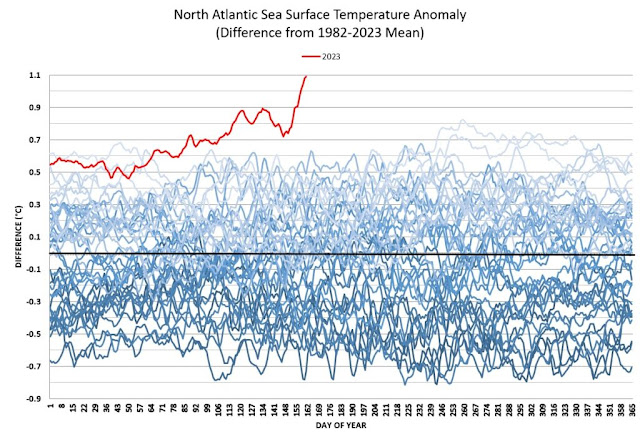The image below, created by Eliot Jacobson, shows the North Atlantic sea surface temperature on June 21, for the years 1982-2023.
The image below shows that the North Atlantic sea surface temperature was 23.3°C on June 21, 2023 (on the black line), 0.9°C higher than the 22.4°C on June 21, 2022 (on the orange line). A record high of 24.9°C was reached on September 4, 2022, even while La Niña then was suppressing the temperature, whereas now there's an El Niño.
 |
| [ click on images to enlarge ] |
Global sea ice extent was at a record low for the time of year on June 23, 2023, i.e. only 21.57 million km², as illustrated by the image below.
 |
| [ click on images to enlarge ] |
Contributing to this is very low Antarctic sea ice extent. The image below shows Antarctic sea ice extent up to June 23, 2023. Values in the column on the left are for February 16; Antarctic sea ice extent reached a record minimum on February 16, 2023. Values in the column on the right are for June 23. Highlighted are three years: 2023 (red), 2022 (blue) and 2016 (black). Antarctic sea ice extent was also very low at the end of the year 2016, which was a strong El Niño year, yet extent was even lower at the very end of the year in 2022, even though that was during a La Niña.
In addition, the Jet Stream is strongly deformed, and this threatens to strengthen heatwaves extending over the Arctic Ocean and causing hot water from rivers to enter the Arctic Ocean, and to strengthen storms accelerating the flow of ocean heat into the Arctic Ocean, while fires and storms contribute to darkening of the sea ice, further speeding up its demise.
The danger is that, as El Niño strengthens and as ocean heat keeps entering the Arctic Ocean from the Atlantic Ocean and the Pacific Ocean, a huge amount of heat will abruptly be pushed into the Arctic Ocean.
This danger is illustrated by the image on the right, showing the Jet Stream pushing wind at a speed of 126 km/h (78 mph) up through Fram Strait (at the green circle) into the Arctic Ocean on June 21, 2023.
This situation threatens to cause massive loss of Arctic sea ice over the coming months, with water in the Arctic Ocean heating up strongly due to loss of the latent heat buffer and loss of albedo.
This in turn threatens to trigger methane eruptions from the seafloor of the Arctic Ocean, a threat that has been described many times before, such as here, here and here.
 |
| [ Latent heat loss, feedback #14 on the Feedbacks page ] |
 |
| [ see the Extinction page ] |
In addition, there are further events and developments that could unfold and make things even worse.
The bar on the right depicts the threat, as discussed at the Extinction page.
In conclusion, the situation is dire and calls for support for a Climate Emergency Declaration.
Links
• Arctic sea ice under threat
• Arctic sea ice under threat - update 1
• Arctic sea ice under threat - update 2
• Arctic sea ice under threat - update 3
• Eliot Jacobson - North Atlantic sea surface temperature anomaly through June 20, 2023
• Eliot Jacobson - North Atlantic sea surface temperature on June 21, for the years 1982-2023
https://twitter.com/EliotJacobson/status/1672232859409723392/photo/1
https://twitter.com/EliotJacobson/status/1672232859409723392/photo/1
• Climate Reanalyzer - Daily sea surface temperatures
https://climatereanalyzer.org/clim/sst_daily
https://climatereanalyzer.org/clim/sst_daily
• NOAA - The National Centers for Environment Prediction Climate Forecast System Version 2
• NOAA - Climate Prediction Center - ENSO Diagnostic Discussions
https://www.cpc.ncep.noaa.gov/products/analysis_monitoring/enso_advisory/ensodisc.shtml
• University of Bremen - sea ice concentration and thickness
https://seaice.uni-bremen.de/start
• NASA Worldview
https://worldview.earthdata.nasa.gov
• Extinction
• Climate Plan
https://arctic-news.blogspot.com/p/climateplan.html
• Climate Emergency Declaration
https://arctic-news.blogspot.com/p/climate-emergency-declaration.html
• University of Bremen - sea ice concentration and thickness
https://seaice.uni-bremen.de/start
• NASA Worldview
https://worldview.earthdata.nasa.gov
• Wetland emission and atmospheric sink changes explain methane growth in 2020 - by Sushi Peng et al.
https://www.nature.com/articles/s41586-022-05447-w
• Will there be Arctic sea ice left in September 2023?
• Will there be Arctic sea ice left in September 2023?
• NOAA - sea surface temperature
• Nullschool.net
• Latent Heat
• Albedo
• Extinction
https://arctic-news.blogspot.com/p/climateplan.html
• Climate Emergency Declaration
https://arctic-news.blogspot.com/p/climate-emergency-declaration.html























